
What is Condyloma?
Condyloma is a disease caused by the Human Papillomavirus (HPV), which is a sexually transmitted infection. Certain types of HPV cause warts in the genital area, around the anus, or inside the mouth. These warts typically appear as small, raised, cauliflower-like growths on the skin or mucous membranes. Condylomas can occur in both men and women, but they are more commonly diagnosed in women. Condylomas are contagious and can easily spread through sexual contact. Therefore, it is important to avoid unprotected sexual intercourse and to have regular health check-ups.
People with HPV infection often do not show symptoms but can still transmit the infection to others.
What is Condyloma?
Condyloma refers to warts that appear as a result of HPV infection. These warts can be found in the genital area, around the anus, or inside the mouth. Condylomas are generally described as small, raised, cauliflower-like growths on the skin or mucous membranes. They can occur in both men and women, but they are more commonly seen in women. This sexually transmitted infection can easily spread through unprotected sexual contact, making it important to pay attention to prevention methods. Condylomas are significant not only for aesthetic concerns but also for health reasons.
How is Condyloma Recognized?
The recognition of condylomas is typically based on physical symptoms. The presence of small, raised, cauliflower-like warts in the genital area, around the anus, or inside the mouth may indicate condylomas. These warts are usually painless but may be accompanied by symptoms such as itching, discomfort, or bleeding. Diagnosis of condylomas is made through a physical examination by a specialist and, if necessary, a biopsy. Additional tests, such as a Pap smear or HPV DNA test, may be conducted to detect HPV infection. Early diagnosis and treatment are crucial to prevent the spread of the disease.
What are the Symptoms of Condyloma?
The symptoms of condyloma vary depending on the location of the warts and the severity of the HPV infection. They generally appear as small, raised, cauliflower-like warts in the genital area, around the anus, or inside the mouth. These warts are usually painless but can also present symptoms such as itching, discomfort, or bleeding. In some cases, condylomas may cause irritation in the skin or mucous membranes, increasing the risk of secondary infection.
How is Condyloma Treated?
The treatment of condyloma depends on the number, size, and location of the warts. Specialist doctors evaluate the patient’s condition to determine the most appropriate treatment method. Treatment options include topical medications, cryotherapy (freezing method), laser therapy, and surgical intervention. Topical medications are applied directly to the warts, causing them to shrink and eventually disappear over time.
Do Condylomas Recur?
There is a risk of recurrence of condylomas because HPV infection cannot be completely cured. Even if the warts disappear after treatment, the virus may remain in the body and become active again under suitable conditions. Therefore, regular follow-ups and check-ups after treatment are important. Additionally, getting the HPV vaccine is an effective measure to reduce the risk of reinfection.
Leave a reply
Leave a reply